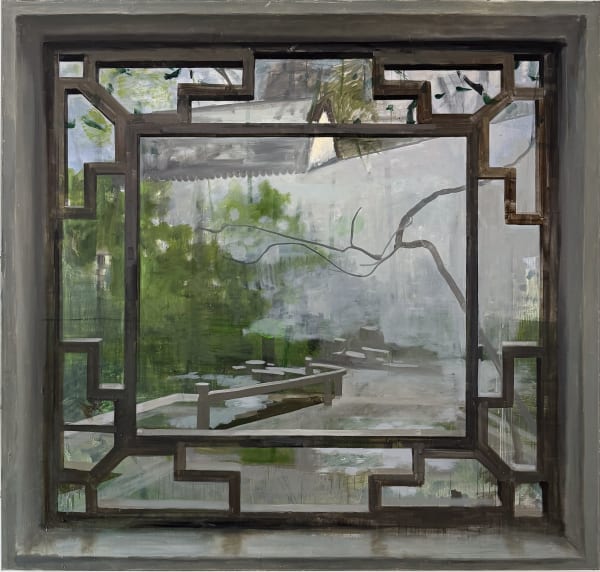With my ancestral spirit I dwell beneath the bamboo, gently shaded by its foliage.
I see the green of the stalks, smell the scent of the leaves, listen to the murmur of wind and rain - and fall asleep.
When cold winds storm, when rain comes suddenly and fiercely, neither downpour nor tempest lingers for long.
Yet neither wind, nor rain, nor sunshine reaches its stillness - upright, slender, and proud.
Bamboo bears writing, history, poetry - how much has it passed on?
I pull over my small stool, sit in the grove, studying the old,
recognizing the new.
- Yang Kailiang
Spring of the Jiachen Year, 2024
Kailiang Yang is a painter of transitions.
His recent works—ethereal cityscapes in silvery blues and muted greys - float between the visible and the remembered. Rain-slicked streets, bridges at dusk, faceless façades: often devoid of people, yet thick with quiet atmosphere. A solitary car beneath a white moon, a path winding through fog, a window overlooking a too-silent courtyard - Yang captures the world as if it were vanishing in the very moment it is seen.
Following in the tradition of the flâneur, Yang does not wander the city to record its bustle, but to distil its soul. He paints not from observation, but from memory - a slow gaze, a painterly breath. The result is a visual language beyond the moment, where brushstrokes become whispers, and what is unspoken is as present as what is seen.
At the heart of the exhibition stands Bamboo, a five-part painting that gazes outward from within - a garden of slender stalks and green suggestions. Bamboo becomes more than a motif here: it becomes a symbol. Of endurance, gentleness, continuity. In a short poem by the artist, it is described as shelter, memory, and teacher - an ancient companion for those who listen. The paintings themselves follow the same principle: they do not display, they offer space.
This idea of space - as refuge, as pause—runs through the entire exhibition. Some works dissolve almost into mist (Sea, 40 × 30 cm, 2025, oil / acrylic on wood), others hint at distant paths (Jingsi Street, 24 × 40 cm, 2025, oil / acrylic on wood) or ghostly vegetation along riverbanks (Silver River 2, 30 × 40 cm, 2025, oil / acrylic on wood). What connects them is not the motif, but the mood. Yang’s painterly surfaces are veils of weather and memory. As his teacher Norbert Schwontkowski once wrote: “There are rare moments when a painter invents a tone no one has ever heard before.”
Born in 1974 in Jinan, Shandong Province, Yang first studied at the Shandong Art University, then in Hamburg under Norbert Schwontkowski and Werner Büttner. His work has been exhibited at institutions including the KW Institute for Contemporary Art, Kunsthaus Hamburg, Kunsthalle Dresden, and the National Art Museum of China.
Today, Yang lives with his family once again in Jinan. Yet his painting remains a place in-between: between continents, stories, and languages. A cultural bridge, without ever being didactic. He does not “translate” between East and West - he breathes both at once.
Together, the works presented here form a quiet constellation - a visual diary without narrative, where light and stillness carry the weight of meaning.
-
 Yang Kailiang, Bambus
Yang Kailiang, Bambus -
 Yang Kailiang, August, 2025
Yang Kailiang, August, 2025 -
 Yang Kailiang, De He Yuan (Fenster zum Hintergarten), 2009
Yang Kailiang, De He Yuan (Fenster zum Hintergarten), 2009 -
 Yang Kailiang, De He Yuan (Hochtor und Fenster zum Garten) Part 2, 2009
Yang Kailiang, De He Yuan (Hochtor und Fenster zum Garten) Part 2, 2009
-
 Yang Kailiang, Jingsi Straße, 2025
Yang Kailiang, Jingsi Straße, 2025 -
 Yang Kailiang, Kleines Bötchen, 2025
Yang Kailiang, Kleines Bötchen, 2025 -
 Yang Kailiang, Kleines Brückchen, 2025
Yang Kailiang, Kleines Brückchen, 2025 -
 Yang Kailiang, Lange Nacht, 2025
Yang Kailiang, Lange Nacht, 2025
-
 Yang Kailiang, Ma Ta, 2025
Yang Kailiang, Ma Ta, 2025 -
 Yang Kailiang, Meer, 2025
Yang Kailiang, Meer, 2025 -
 Yang Kailiang, Meine Sonne, 2025
Yang Kailiang, Meine Sonne, 2025 -
 Yang Kailiang, Meine Sonne 1, 2025
Yang Kailiang, Meine Sonne 1, 2025

























